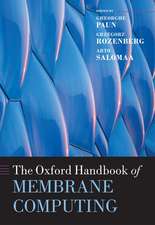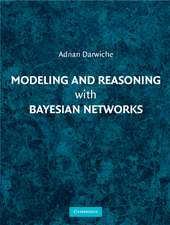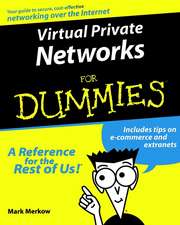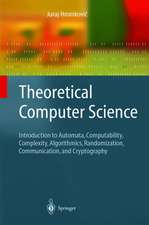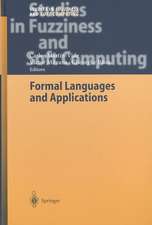Neural Networks and Analog Computation: Beyond the Turing Limit: Progress in Theoretical Computer Science
Autor Hava T. Siegelmannen Limba Engleză Hardback – dec 1998
Toate formatele și edițiile
| Toate formatele și edițiile | Preț | Express |
|---|---|---|
| Paperback (1) | 982.36 lei 6-8 săpt. | |
| Birkhäuser Boston – 21 oct 2012 | 982.36 lei 6-8 săpt. | |
| Hardback (1) | 988.32 lei 6-8 săpt. | |
| Birkhäuser Boston – dec 1998 | 988.32 lei 6-8 săpt. |
Din seria Progress in Theoretical Computer Science
- 20%
 Preț: 644.98 lei
Preț: 644.98 lei - 20%
 Preț: 645.47 lei
Preț: 645.47 lei - 20%
 Preț: 650.59 lei
Preț: 650.59 lei - 20%
 Preț: 601.00 lei
Preț: 601.00 lei - 20%
 Preț: 1000.38 lei
Preț: 1000.38 lei - 20%
 Preț: 648.95 lei
Preț: 648.95 lei - 20%
 Preț: 650.08 lei
Preț: 650.08 lei - 20%
 Preț: 648.26 lei
Preț: 648.26 lei - 20%
 Preț: 656.03 lei
Preț: 656.03 lei - 20%
 Preț: 658.33 lei
Preț: 658.33 lei - 20%
 Preț: 646.30 lei
Preț: 646.30 lei - 20%
 Preț: 650.73 lei
Preț: 650.73 lei -
 Preț: 379.86 lei
Preț: 379.86 lei - 15%
 Preț: 584.92 lei
Preț: 584.92 lei - 20%
 Preț: 589.87 lei
Preț: 589.87 lei -
 Preț: 378.34 lei
Preț: 378.34 lei -
 Preț: 386.61 lei
Preț: 386.61 lei -
 Preț: 385.47 lei
Preț: 385.47 lei - 15%
 Preț: 540.24 lei
Preț: 540.24 lei
Preț: 988.32 lei
Preț vechi: 1235.41 lei
-20% Nou
Puncte Express: 1482
Preț estimativ în valută:
189.11€ • 197.47$ • 156.16£
189.11€ • 197.47$ • 156.16£
Carte tipărită la comandă
Livrare economică 16-30 aprilie
Preluare comenzi: 021 569.72.76
Specificații
ISBN-13: 9780817639495
ISBN-10: 0817639497
Pagini: 181
Ilustrații: XIV, 181 p.
Dimensiuni: 155 x 235 x 15 mm
Greutate: 0.45 kg
Ediția:1999
Editura: Birkhäuser Boston
Colecția Birkhäuser
Seria Progress in Theoretical Computer Science
Locul publicării:Boston, MA, United States
ISBN-10: 0817639497
Pagini: 181
Ilustrații: XIV, 181 p.
Dimensiuni: 155 x 235 x 15 mm
Greutate: 0.45 kg
Ediția:1999
Editura: Birkhäuser Boston
Colecția Birkhäuser
Seria Progress in Theoretical Computer Science
Locul publicării:Boston, MA, United States
Public țintă
ResearchCuprins
1 Computational Complexity.- 1.1 Neural Networks.- 1.2 Automata: A General Introduction.- 1.3 Finite Automata.- 1.4 The Turing Machine.- 1.5 Probabilistic Turing Machines.- 1.6 Nondeterministic Turing Machines.- 1.7 Oracle Turing Machines.- 1.8 Advice Turing Machines.- 1.9 Notes.- 2 The Model.- 2.1 Variants of the Network.- 2.2 The Network’s Computation.- 2.3 Integer Weights.- 3 Networks with Rational Weights.- 3.1 The Turing Equivalence Theorem.- 3.2 Highlights of the Proof.- 3.3 The Simulation.- 3.4 Network with Four Layers.- 3.5 Real-Time Simulation.- 3.6 Inputs and Outputs.- 3.7 Universal Network.- 3.8 Nondeterministic Computation.- 4 Networks with Real Weights.- 4.1 Simulating Circuit Families.- 4.2 Networks Simulation by Circuits.- 4.3 Networks versus Threshold Circuits.- 4.4 Corollaries.- 5 Kolmogorov Weights: Between P and P/poly.- 5.1 Kolmogorov Complexity and Reals.- 5.2 Tally Oracles and Neural Networks.- 5.3 Kolmogorov Weights and Advice Classes.- 5.4 The Hierarchy Theorem.- 6 Space and Precision.- 6.1 Equivalence of Space and Precision.- 6.2 Fixed Precision Variable Sized Nets.- 7 Universality of Sigmoidal Networks.- 7.1 Alarm Clock Machines.- 7.2 Restless Counters.- 7.3 Sigmoidal Networks are Universal.- 7.4 Conclusions.- 8 Different-limits Networks.- 8.1 At Least Finite Automata.- 8.2 Proof of the Interpolation Lemma.- 9 Stochastic Dynamics.- 9.1 Stochastic Networks.- 9.2 The Main Results.- 9.3 Integer Stochastic Networks.- 9.4 Rational Stochastic Networks.- 9.5 Real Stochastic Networks.- 9.6 Unreliable Networks.- 9.7 Nondeterministic Stochastic Networks.- 10 Generalized Processor Networks.- 10.1 Generalized Networks: Definition.- 10.2 Bounded Precision.- 10.3 Equivalence with Neural Networks.- 10.4 Robustness.- 11 Analog Computation.- 11.1 DiscreteTime Models.- 11.2 Continuous Time Models.- 11.3 Hybrid Models.- 11.4 Dissipative Models.- 12 Computation Beyond the Turing Limit.- 12.1 The Analog Shift Map.- 12.2 Analog Shift and Computation.- 12.3 Physical Relevance.- 12.4 Conclusions.
Recenzii
"All of the three primary questions are considered: What computational models can the net simulate (within polynomial bounds)? What are the computational complexity classes that are relevant to the net? How does the net (which, after all, is an analog device) relate to Church’s thesis? Moreover the power of the basic model is also analyzed when the domain of reals is replaced by the rationals and the integers."
—Mathematical Reviews
"Siegelmann's book focuses on the computational complexities of neural networks and making this research accessible...the book accomplishes the said task nicely."
---SIAM Review, Vol. 42, No 3.
—Mathematical Reviews
"Siegelmann's book focuses on the computational complexities of neural networks and making this research accessible...the book accomplishes the said task nicely."
---SIAM Review, Vol. 42, No 3.
Textul de pe ultima copertă
The theoretical foundations of Neural Networks and Analog Computation conceptualize neural networks as a particular type of computer consisting of multiple assemblies of basic processors interconnected in an intricate structure. Examining these networks under various resource constraints reveals a continuum of computational devices, several of which coincide with well-known classical models. What emerges is a Church-Turing-like thesis, applied to the field of analog computation, which features the neural network model in place of the digital Turing machine. This new concept can serve as a point of departure for the development of alternative, supra-Turing, computational theories. On a mathematical level, the treatment of neural computations enriches the theory of computation but also explicated the computational complexity associated with biological networks, adaptive engineering tools, and related models from the fields of control theory and nonlinear dynamics.
The topics covered in this work will appeal to a wide readership from a variety of disciplines. Special care has been taken to explain the theory clearly and concisely. The first chapter review s the fundamental terms of modern computational theory from the point of view of neural networks and serves as a reference for the remainder of the book. Each of the subsequent chapters opens with introductory material and proceeds to explain the chapter’s connection to the development of the theory. Thereafter, the concept is defined in mathematical terms.
Although the notion of a neural network essentially arises from biology, many engineering applications have been found through highly idealized and simplified models of neuron behavior. Particular areas of application have been as diverse as explosives detection in airport security, signature verification, financial and medical times series prediction, vision, speech processing, robotics, nonlinear control, and signal processing. The focus inall of these models is entirely on the behavior of networks as computer.
The material in this book will be of interest to researchers in a variety of engineering and applied sciences disciplines. In addition, the work may provide the base of a graduate-level seminar in neural networks for computer science students.
The topics covered in this work will appeal to a wide readership from a variety of disciplines. Special care has been taken to explain the theory clearly and concisely. The first chapter review s the fundamental terms of modern computational theory from the point of view of neural networks and serves as a reference for the remainder of the book. Each of the subsequent chapters opens with introductory material and proceeds to explain the chapter’s connection to the development of the theory. Thereafter, the concept is defined in mathematical terms.
Although the notion of a neural network essentially arises from biology, many engineering applications have been found through highly idealized and simplified models of neuron behavior. Particular areas of application have been as diverse as explosives detection in airport security, signature verification, financial and medical times series prediction, vision, speech processing, robotics, nonlinear control, and signal processing. The focus inall of these models is entirely on the behavior of networks as computer.
The material in this book will be of interest to researchers in a variety of engineering and applied sciences disciplines. In addition, the work may provide the base of a graduate-level seminar in neural networks for computer science students.



